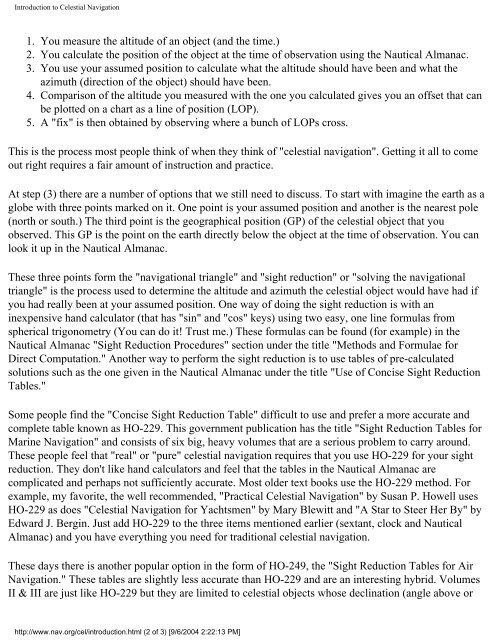Introduction to Celestial Navigation
Introduction to Celestial Navigation
Introduction to Celestial Navigation
Create successful ePaper yourself
Turn your PDF publications into a flip-book with our unique Google optimized e-Paper software.
<strong>Introduction</strong> <strong>to</strong> <strong>Celestial</strong> <strong>Navigation</strong>1. You measure the altitude of an object (and the time.)2. You calculate the position of the object at the time of observation using the Nautical Almanac.3. You use your assumed position <strong>to</strong> calculate what the altitude should have been and what theazimuth (direction of the object) should have been.4. Comparison of the altitude you measured with the one you calculated gives you an offset that canbe plotted on a chart as a line of position (LOP).5. A "fix" is then obtained by observing where a bunch of LOPs cross.This is the process most people think of when they think of "celestial navigation". Getting it all <strong>to</strong> comeout right requires a fair amount of instruction and practice.At step (3) there are a number of options that we still need <strong>to</strong> discuss. To start with imagine the earth as aglobe with three points marked on it. One point is your assumed position and another is the nearest pole(north or south.) The third point is the geographical position (GP) of the celestial object that youobserved. This GP is the point on the earth directly below the object at the time of observation. You canlook it up in the Nautical Almanac.These three points form the "navigational triangle" and "sight reduction" or "solving the navigationaltriangle" is the process used <strong>to</strong> determine the altitude and azimuth the celestial object would have had ifyou had really been at your assumed position. One way of doing the sight reduction is with aninexpensive hand calcula<strong>to</strong>r (that has "sin" and "cos" keys) using two easy, one line formulas fromspherical trigonometry (You can do it! Trust me.) These formulas can be found (for example) in theNautical Almanac "Sight Reduction Procedures" section under the title "Methods and Formulae forDirect Computation." Another way <strong>to</strong> perform the sight reduction is <strong>to</strong> use tables of pre-calculatedsolutions such as the one given in the Nautical Almanac under the title "Use of Concise Sight ReductionTables."Some people find the "Concise Sight Reduction Table" difficult <strong>to</strong> use and prefer a more accurate andcomplete table known as HO-229. This government publication has the title "Sight Reduction Tables forMarine <strong>Navigation</strong>" and consists of six big, heavy volumes that are a serious problem <strong>to</strong> carry around.These people feel that "real" or "pure" celestial navigation requires that you use HO-229 for your sightreduction. They don't like hand calcula<strong>to</strong>rs and feel that the tables in the Nautical Almanac arecomplicated and perhaps not sufficiently accurate. Most older text books use the HO-229 method. Forexample, my favorite, the well recommended, "Practical <strong>Celestial</strong> <strong>Navigation</strong>" by Susan P. Howell usesHO-229 as does "<strong>Celestial</strong> <strong>Navigation</strong> for Yachtsmen" by Mary Blewitt and "A Star <strong>to</strong> Steer Her By" byEdward J. Bergin. Just add HO-229 <strong>to</strong> the three items mentioned earlier (sextant, clock and NauticalAlmanac) and you have everything you need for traditional celestial navigation.These days there is another popular option in the form of HO-249, the "Sight Reduction Tables for Air<strong>Navigation</strong>." These tables are slightly less accurate than HO-229 and are an interesting hybrid. VolumesII & III are just like HO-229 but they are limited <strong>to</strong> celestial objects whose declination (angle above orhttp://www.nav.org/cel/introduction.html (2 of 3) [9/6/2004 2:22:13 PM]














